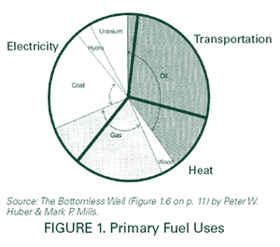Under Construction 
| |||||||||||||||||||||||||||||||||||||||||||||||
 |
| ||||||||||||||||||||||||||||||||||||||||||||||
|
Sourcer: Huber and Mills, The Bottomless Well Source: Energy and The Environment: Myths and Facts (www.manhattan-institute.org/energymyths/myth1.htm) Primary Fuel Uses
In Massachusetts, the fuel mix for electricity production is:
37% oil
1998 Energy Consumption World 12.8 TW US 3.3 TW (26%) We have 5% of the population but use 26% of the resources. Source: Energy and Transportation: Challenges for the Chemical Sciences in the 21st Century (2003) Transportation: Average car in New Jersey 20 MPG 12,500 miles/yearU.S. Source of Oil | |||||||||||||||||||||||||||||||||||||||||||||||
|
| ||||||||||||||||||||||||||||||||||||||||||||||
|
in 2005 the US used 20.8 billion barrels of oil (BBO) per year Source: U.S. Energy Information Administration (EIA) www.energyjustice.net 2007
The average American uses twice the energy of the average European and three times that of the average Japanese. Energy: The metric unit for energy is the joule (1J). 1 joule = 1 watt (W) * 1 sec 1 GJ = Giga (109) Joul 1 EJ = Exa (1018) Joul = 109 GJ = .95 Quad 1 Btu British thermal unit 1,055 J 1 KWh Kilowatt-hour 3,412 Btu 1 quad quadrillion Btu 1015 Btu = 1.055 EJ 1 toe (metric) ton of oil equivalent 39.7 million Btu = 42 GJ 1 bboe billion barrels of oil equivalent 5.8 million Btu = 1700 kWh 1 tce (metric) ton of coal equivalent 27.8 million Btu 1 mcf nat.gas (LHV) = 10.26 therm = 1.026 mmBtu = 1.082 GJ Power: 1 TW = Terra 10^12 (1 trillion) Watt = 31.5 EJ/year Number prefixes (K, M, G, ...) Other Terms: bbl: barrel(s) CNG: Compressed Natural Gas GJ: Giga (109) Joul LPG: Liquefied Petroleum Gas MMbbl: one million (106) British thermal units MJ: one million joules L: Liter = 0.2642 gal The Institute for the Analysis of Global Security - Gossary Energy Content (Lower Heating Values): Crude Oil = 6.119 GJ/bbl = 5.8 mmBtu/bbl = 39.7 mmBtu/ton = 145.7 MJ/gal = 38.5 MJ/L = 41.868 MJ/kg (GJ/ton) Gasoline = 121.8 MJ/gal = 32.2 MJ/L = 43.69 MJ/kg =115 mBtu/gal Diesel = 135.5 MJ/gal = 35.6 MJ/L = 41.84 MJ/kg =128 mBtu/gal Ethanol = 80.2 MJ/gal = 21.2 MJ/L = 26.86 MJ/kg = 76 mBtu/gal Biodiesel = 124.8 MJ/gal = 33.0 MJ/L = 37.47 MJ/kg =121mBtu/gal Hydrogen @ 35MPa (HHV) = 10.22 MJ/gal = 2.7MJ/L = 120 MJ/kg UN Standard Coal = 30 GJ/ton Bituminous = 27-30 GJ/ton (MJ/kg) = 25-28 mmBtu/ton Subbitum. = 20-26 GJ/ton (MJ/kg) = 19-24 mmBtu/ton Lignite = 10-19 GJ/ton (MJ/kg) = 9-18 mmBtu/ton Natural Gas @ STP = 37 MJ/m3 = 36mBtu/m3 = 1025 Btu/ ft3 CNG @ 20MPa = 35.16 MJ/gal = 9.288 MJ/L = 50.04 MJ/kg LPG@1.5MPa =88.1MJ/gal=23.3MJ/L=19.8mBtu/lb=84.5 mBtu/gal Methanol = 63.3 MJ/gal = 16.71 MJ/L = 21.1MJ/kg = 52.8 mBtu/gal Air-Dried (20% Moisture Content) Wood = 15 GJ/ton Uranium = 80 GJ/g fissioned = 400 GJ/kg mined (fsnĠd =.5% mnĠd)Energy Abbreviations Page at DOE Conversion Page Measurement notations and abbreviations and prefixes (K, M, G, ...)
Books:
Links: Return to Environment
| |||||||||||||||||||||||||||||||||||||||||||||||